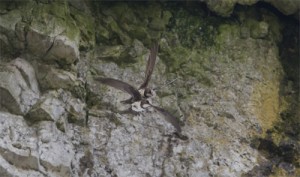 During a trip from July 1st till 8th 2013 to observe birds in Romania and Bulgaria a remarkable sighting could be noted. A couple of Alpine Swift (Apus melba) was seen flying below a crag in a steep rock and copulated for several seconds. This could be seen in a beautiful gorge near the town of Zărneşti (Zarnesti), in the Piatra Craiului Nationalpark. Zarnesti is located south of Brașov (Brasov) approx.. 180km away from the capital of Romania, Bucharest.
During a trip from July 1st till 8th 2013 to observe birds in Romania and Bulgaria a remarkable sighting could be noted. A couple of Alpine Swift (Apus melba) was seen flying below a crag in a steep rock and copulated for several seconds. This could be seen in a beautiful gorge near the town of Zărneşti (Zarnesti), in the Piatra Craiului Nationalpark. Zarnesti is located south of Brașov (Brasov) approx.. 180km away from the capital of Romania, Bucharest.
In the Western Palearctic Alpine Swifts breed in mountains mainly in southern Europe. Like Common Swifts, they are migratory, and winter in southern Africa. As happened in that gorge the species builds its nest on cliff faces typically. Alpine Swifts build their nests in colonies in a suitable cliff hole or cave. It is well known, that Alpine Swifts spend most of their lives in the air, living on the insects they catch but up to now, a copula in flight could not be photographed. At least Bird-lens could not find a photo on the web. Consequently Bird-lens is proud to show images of a flight copula of this remarkable species.
As is mentioned in the „Handbuch der Vögel Mitteleuropas“ (Handbook of the birds of Central Europe), Volume 9 “Columbiformes – Piciformes” by Urs N. Glutz von Blotzheim, the male Alpine Swift usually holds the female with the beak in the neck and with the feet in the back plumage of the quiet female partner in copulation. While the female raises its tail, the male winds down his abdomen. For the Common Swift (Apus apus), also a copula in flight is described. Bird-lens is proud to show images of a flight copula of the much scarcer species Alpine Swift. A copula in flight resembles a courtship flight. During courtship two swifts follow each other at intervals of usually 1-10 meters. Suddenly the rear bird rushes with a heightened and attacks the bird at the front. In most cases, the first bird raises the wings in a V-position and slides. The second bird then breaks off the attack or continues it, after which the front swift gives-up the V-position and flees.  These maneuvers are accompanied by loud shouts. Sometimes the advanced flying bird is overtaken during the V-position. The other swift – keeping the wings high as well – imposes itself between the wings of the front bird and both fall down crying, but then dissolve quickly. Copula in flight in Common Swift are described only in good weather and usually observed at heights of 10-80 m. The quietly and straight forward flying female suddenly begins to vibrate his wings, losing speed and glides with wings held horizontally. The following male increases his pace, hovering at an angle from above over the partner and claws into the back feathers of the female. Sometimes this landing is preceded by a trembling wing of the male, which will be answered by females as well. During mating, the wings remain calm, horizontally in the female, the male in a V-position. It occasionally happens that the male or both birds move the wings to prevent slippage of the male. As could be observed on the occasion when the images were shot, the pair is losing height and speed during copulation and disconnects after 2-4 seconds.
These maneuvers are accompanied by loud shouts. Sometimes the advanced flying bird is overtaken during the V-position. The other swift – keeping the wings high as well – imposes itself between the wings of the front bird and both fall down crying, but then dissolve quickly. Copula in flight in Common Swift are described only in good weather and usually observed at heights of 10-80 m. The quietly and straight forward flying female suddenly begins to vibrate his wings, losing speed and glides with wings held horizontally. The following male increases his pace, hovering at an angle from above over the partner and claws into the back feathers of the female. Sometimes this landing is preceded by a trembling wing of the male, which will be answered by females as well. During mating, the wings remain calm, horizontally in the female, the male in a V-position. It occasionally happens that the male or both birds move the wings to prevent slippage of the male. As could be observed on the occasion when the images were shot, the pair is losing height and speed during copulation and disconnects after 2-4 seconds.
To cope with the growing demand for top shots of the rarer species of the Palearctic Bird-Lens is keen to enrich the range of pictures of birds you can find in the western palearctic. Several trips to Romania and to other remote places to capture images of rare birds of the Western Palearctic were very successful. The nice image you see in the blog is only a first impression, what you will find in the gallery in the “Pictures Shop” very soon. Just give me a message, if I could serve you with an image needed before the new pictures are online.
Other successful shootings you can see under: www.bird-lens.com in the pictures shop